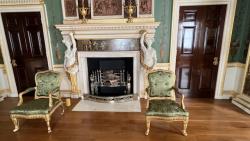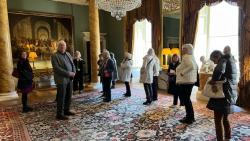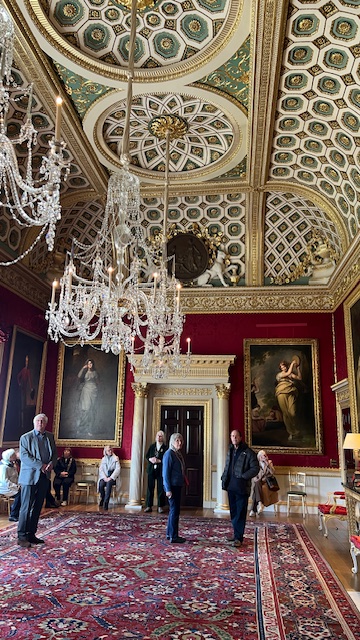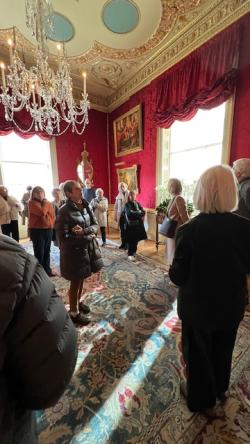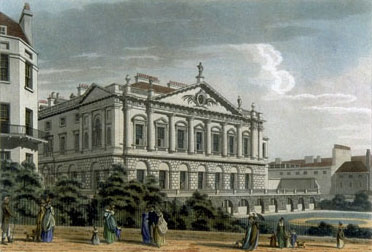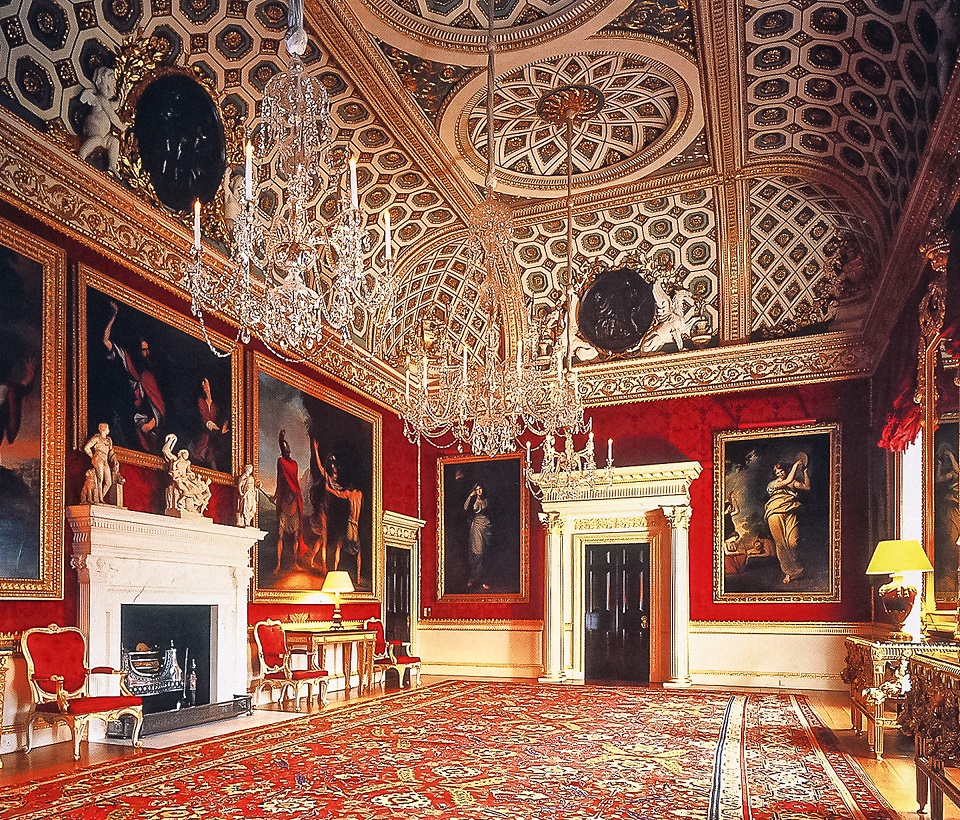Day Trip Review by Gaye Hudson, with photographs by Judith Stephenson-Hodges
On Monday 3 March, 50 members of TASH were privately guided round the magnificent London home of the Spencer family.
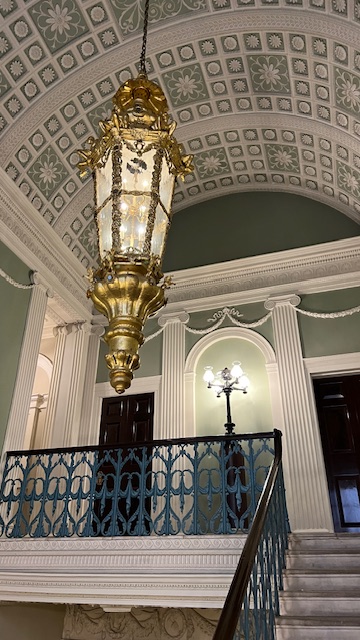 Spencer House was begun in 1756 for John, later First Earl, Spencer and his wife Georgiana, nee Poyntz. They had married in 1755 and their relationship was a rare love match. Despite inheriting a large fortune and numerous houses, John Spencer lacked a London property of suitable grandeur and so the young couple began construction of a splendid new house in St James’s, overlooking Green Park. The house would provide the Spencer’s not only with a family home in the city, but a venue for lavish entertaining and the display of their growing art collection.
Spencer House was begun in 1756 for John, later First Earl, Spencer and his wife Georgiana, nee Poyntz. They had married in 1755 and their relationship was a rare love match. Despite inheriting a large fortune and numerous houses, John Spencer lacked a London property of suitable grandeur and so the young couple began construction of a splendid new house in St James’s, overlooking Green Park. The house would provide the Spencer’s not only with a family home in the city, but a venue for lavish entertaining and the display of their growing art collection.
As their architect, the Spencer’s chose John Vardy who was heavily influenced by the Palladian style which had dominated British design during the first half of the eighteenth century but by the 1750s was beginning to seem outdated. Therefore, Vardy was only able to complete the outside of Spencer House and the decoration of the ground floor rooms before he was side-lined in favour of James ‘Athenian’ Stuart. Stuart was a pioneer of the new neoclassical style and as a result, Spencer House contains some of the earliest fully realised neoclassical interiors in England.
By 1926 financial pressures forced the Spencer’s to move out, letting it to a commercial tenant, the Ladies Army and Navy Club. In doing so it saved Spencer House from sharing the fate of so many other great London houses which were sold and demolished to make way for new hotels and office blocks.
Concerned for the safety of the house during the Blitz, in May 1941 the Spencer’s sent workmen to remove architectural fixtures from the State Rooms, including doorcases, chimneypieces, chair rails and even skirting boards, and bring them back to Althorp. Many of these fixtures were eventually installed in the rooms at Althorp where they remain today.
Jacob, 4th Lord Rothschild, had always admired Spencer House and when the lease became available in 1981 he saw an opportunity to restore the building to a state worthy of its historical and architectural importance. A new lease was signed in 1985, work began on site in 1987 and the newly restored house was officially reopened in 1990 by Diana, Princess of Wales, a direct descendant of the First Earl and Lady Spencer.
For a fuller history or this great house and its restoration visit: History | Historic House in London | Spencer House
~~~~~~~~~~~~~~~~~~~~~~~~~~~~~~~~~~~~~~~~~~~~~~~~~~~~~~~~~~~~~~~~~~~~~
Day Trip Synopsis:
Members will be treated to a private viewing of the house with guides to escort us around the eight state rooms. Spencer House was not just a family home and a venue for entertaining; it was also a private art gallery where the Spencers could show off some of the most prized objects of their collection. The executive coach will depart Henley Rugby Club at 9am and we propose to be back in Henley by 5.30pm. As there are no food or drink facilities at the venue , we suggest you bring a drink with you on the morning coach trip. The tour will end by 12.30 leaving you free to plan the rest of the day - shopping in Jermyn Street, lunch with friends in St James's, further culture with a trip to the National Portrait Gallery or just a gentle Spring stroll through Green Park. Everyone will need to be back at the coach by 3.30pm.
View of Spencer House, circa 1800
Ever since its creation for the First Lord and Lady Spencer between 1756 and 1766, Spencer House has been widely admired as one of the most beautiful houses in London. The main façade overlooking Green Park is faced in Portman Stone and consists of a giant Doric Portico. The pediment is topped with statues of three gods - Ceres, Bacchus and Flora - resembling a classical temple dedicated to hospitality, love and the arts.
(Please click on the blue print above to continue reading)
As the home of successive Earls and Countesses Spencer, the staterooms of the house became a theatre for the pageant that was London high society. Members of the Spencer family occupied the mansion continuously until 1895, when the house was let out. The Spencers returned for a brief time during the first quarter of the 20th century, after which the house was let at various times as either a club or offices. During the Blitz of the Second World War, it was stripped of its few remaining authentic treasures, specially made furniture, and fireplaces.
Spencer House remains in the ownership of the Earls Spencer, the current freeholder being Charles Spencer, 9th Earl Spencer, brother of Diana, Princess of Wales. However, since the Second World War, the house has been continuously let out. In 1948 it was leased to Christie's auctioneers, in 1956 to the British Oxygen Company, and in 1963 to the Economist Intelligence Unit.
On 25 December 1986, RIT Capital Partners, the family company of Jacob Rothschild, 4th Baron Rothschild, secured a 96-year lease (with an additional 24-year option) with an annual rent of £85,000.
After a ten year restoration, Spencer House was reopened in 1991 by Diana, Princess of Wales. It comprises eight magnificent, noble State Rooms, each with its own distinctive design, character and history.

 Spencer House was begun in 1756 for John, later First Earl, Spencer and his wife Georgiana, nee Poyntz. They had married in 1755 and their relationship was a rare love match. Despite inheriting a large fortune and numerous houses, John Spencer lacked a London property of suitable grandeur and so the young couple began construction of a splendid new house in St James’s, overlooking Green Park. The house would provide the Spencer’s not only with a family home in the city, but a venue for lavish entertaining and the display of their growing art collection.
Spencer House was begun in 1756 for John, later First Earl, Spencer and his wife Georgiana, nee Poyntz. They had married in 1755 and their relationship was a rare love match. Despite inheriting a large fortune and numerous houses, John Spencer lacked a London property of suitable grandeur and so the young couple began construction of a splendid new house in St James’s, overlooking Green Park. The house would provide the Spencer’s not only with a family home in the city, but a venue for lavish entertaining and the display of their growing art collection.